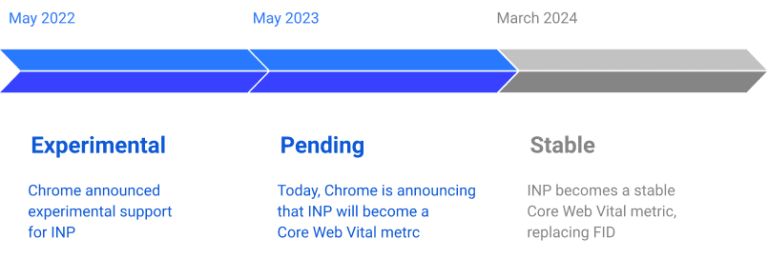What are Core Web Vitals, and why do they matter?
A website’s page performance is measured by Core Web Vitals, a set of specific factors. These factors include the loading time, interactivity, and visual stability of the page. Google’s focus on these metrics is a key part of their drive to enhance user experience, understanding that good sites should be pleasing to the eye, quick to load, and responsive to interactions.
In this guide, we’ll explore the recent and upcoming changes to the Core Web Vitals metrics, with a particular focus on the transition from First Input Delay (FID) – the old guard – to Interaction to Next Paint (INP), which is set to become the new standard for user-interactivity measurement.
The Transition from FID to INP
You may have worked diligently to ensure that your website’s First Input Delay (FID) is in the green zone, only to find that the bar has moved with the introduction of Interaction to Next Paint (INP). Google is dedicateed to reflecting the actual user experience in its rankings through this shift, but it can disrupt your SEO strategies if you’re unprepared.
The essence of INP is capturing the latency from the time a user interacts with your site (e.g., clicking a link) to the time the browser is actually able to begin processing that interaction. Unlike FID, INP takes all user-initiated interactive elements into account, not just the first one. This recognition by INP of a wider range of user interactions aims to capture the totality of user experience and satisfaction more authentically.

Source: https://web.dev/blog/inp-cwv
Understanding the Impact of INP
It’s crucial to grasp the nuances of this new metric. Here’s a deeper look at what the shift from FID to INP means for your website.
FID in Review
FID has been Google’s standard measure for user interactivity for a while, but it’s a single early-stage event that doesn’t necessarily encompass all user actions.
The Power of INP
INP, on the other hand, is more comprehensive. It acknowledges the complexity of user interactions on dynamic and responsive websites, accounting for a chain of actions that users perform.
What is a good INP score?
To guarantee that you are providing user experiences with optimal responsiveness, experts recommend measuring the 75th percentile of page loads in the field, segmented by mobile and desktop devices.
- If the Input Neutral Point (INP) is equal to or less than 200 milliseconds, your page is considered to have good responsiveness.
- An INP between 200 milliseconds and 500 milliseconds indicates that your page’s responsiveness could use some improvement.
- Finally, an INP greater than 500 milliseconds signifies that your page has poor responsiveness.
Source: https://web.dev/articles/inp
Updates in Core Web Vitals and Their Performance Implications
Transitioning to INP is just one piece of the puzzle. Google continuously updates its Web Vitals standards to keep pace with evolving user expectations and technological capabilities. The latest changes bring even finer-grained performance indicators, which, if not met, could adversely affect the user experience and, by extension, your website’s SEO ranking.
These minor updates often translate to major shifts in your site’s performance evaluation, necessitating a proactive approach to maintaining web vitals health. The common denominator across these changes is the need for faster, more responsive, and visually stable web pages.
What happens if you don’t adapt to the changes?
Ignoring the changes can badly affect your website. Firstly, you’ll miss out on the direct benefits of enhanced user experience, which include lower bounce rates, increased session duration, and improved conversion rates. Secondly, your search ranking will take a hit, as Google prioritizes websites that provide superior user experiences, as inferred from the Core Web Vitals metrics.
It’s a competitive world out there, and those who fail to keep up with Google’s core updates could find themselves sidelined by competitors who prioritize their site’s performance and user experience.
How to adapt to INP
Split long tasks
To optimize site responsiveness, it is crucial to break down lengthy tasks that exceed 50 milliseconds into smaller, more manageable components. These prolonged tasks hinder the site’s ability to promptly respond to user interactions. By splitting them into smaller tasks, the site can operate more efficiently and provide a smoother user experience.
Remove unnecessary JavaScript
Excessive JavaScript code leads to a situation where various tasks compete for the main thread’s attention, ultimately slowing down page speed. To address this issue, you can utilize DevTools Coverage, accessible through Developer Tools by navigating to Menu (three dots) -> More tools -> Coverage. This tool allows you to analyze and identify redundant code, thereby optimizing your website’s performance.
Avoid major rendering updates
Enhance the rendering workflow by minimizing the use of requestAnimationFrame, as excessive usage can lead to inefficiencies.
Engage with Fooz for an INP-Optimized Website
We will conduct a comprehensive audit of your website, 30-40 pages of code quality, accessibility, performance, SEO, and UX/UI. Through this process, we will identify any issues, prioritize them, and provide solutions for improvement. By implementing these solutions, your website will achieve favorable results in Google Core Web Vitals, giving you a competitive edge and reducing costs for SEO and SEM.
Conclusion
The transition from FID to INP exemplifies Google’s unwavering commitment to creating an internet environment where user experience reigns supreme. For marketers and webmasters, this necessitates remaining vigilant and adaptable to the evolving landscape.By prioritizing the optimization of your Core Web Vitals, you are not only ensuring alignment with search engine requirements but also investing in the foundation of your online success – the satisfaction of your users.
In the dynamic digital marketplace of 2024, where success benchmarks are constantly being redefined, shifting your website to an INP-centric approach is not merely an enhancement – it is essential for survival.

